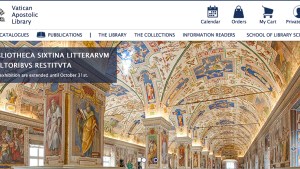At 4:45 pm on Wednesday, December 22, a frightening roar spread alarm throughout the area of Vatican City adjacent to the Belvedere: a catastrophic collapse had occurred in the Vatican Library buildings. Dense columns of dust protruded from the windows and doors of the Library arm that closes off the northern courtyard, while the creaking of beams and crumbling of materials revealed further imminent threats of collapse. From the entrance to the building, dismayed workers and scholars came running out.
This is how the Italian press reported the tragedy at the Vatican just three days before Christmas 1931. In an instant, an entire section of the Vatican Library building had collapsed. The accident killed five workers on the site and destroyed almost 15,000 precious volumes belonging to the sections on English and German history, canon and civil law, epigraphy, and hagiography.

The library’s pro-prefect, the future Cardinal Eugène Tisserant, made the news official, stating that Pope Pius XI had been notified immediately. Two days later, parts of the building, now split in two from roof to the ground floor, collapsed again, causing quite a stir. More than 250 trucks were needed to remove all the rubble.
But on April 3, 1933, less than a year and six months later, Pope Pius XI was able to visit a Vatican Apostolic Library that had been completely restored to its original state— a real feat. The only thing missing were Giovanni Guerra’s famous colorful grotesques of the “Sistine Rooms,” which were restored shortly afterwards. But to what did we owe the eagerness to rebuild?
Scandal in the Vatican
Naturally, the death of the workmen, who were actually renovating the library building, led to the opening of several investigations commissioned by the pope himself. There were two opposing theories: On the one hand, those who believed that the collapse had originated from above, and who considered that the problem lay with the building, designed by the great 16th-century Neapolitan architect Domenico Fontana. The work had been carried out quickly at the time, and the apparently fragile foundations had in fact led to the reinforcement of the central pillars on the first floor, a job entrusted to a company called Fagiani. It was some of this company’s workers who died in the collapse.
And they were the cause of the second theory: that of a collapse from below caused by reckless or even incompetent renovation work. As the workers were renovating a building after signs of wear and tear had already appeared, investigations quickly turned into a chicken-and-egg dilemma.
But the affair was gaining wider public interest, making Msgr. Eugène Tisserant criticize in January “the exaggerated concern that has arisen in public opinion.” But the challenge for the Vatican was also to reassure the international academic community so as not to tarnish the institution’s image after the destruction of numerous volumes, notes architectural historian Nicoletta Marconi in her in-depth study of the incident. It was necessary to rebuild quickly. This may explain Msgr. Tisserant’s insistence that the damage was “entirely repairable.” He wasn’t the only one to want this.
The “librarian pope”
“The library was saved by one fact: the presence of Pius XI in the Vatican,” explains Fr. Giacomo Cardinale, a Vatican Library employee who exhumed photos of the tragedy as part of the exhibition Souvenirs de Babel (March 1 – June 22, 2024), which he curated.
Alerted to the catastrophe, the Pope took the situation to heart, and for good reason: elected in 1922, this scholar had previously held the position of Prefect of the Vatican Library for four years.
Once on the throne of Peter, Pius XI had undertaken major works to modernize the library. He even brought in an American firm specializing in building construction to build a veritable skyscraper of books in an adjacent room formerly given over to mosaics and carriages. Consequently, this catastrophe was a serious setback for him.
When he arrived at the scene of the tragedy, he was quoted as saying, “It was a work of art that shouldn’t have been touched.” Then, according to one of his secretaries, he promised, “The Library will be remade as it was.”
In March 1932, the verdict of the inquiry was in: in the absence of sufficient evidence, no one would be held guilty of the catastrophe, neither Domenico Fontana nor Fagiani. However, Fagiani’s chief engineer was dismissed for inadequate management of the works.
A more secure future
Details of the investigation were never made public. Pius XI subsequently set up a permanent commission for the supervision and conservation of Vatican City monuments, which still exists today under a different name.
The new library structure was built using reinforced concrete, a very modern technique for the time, to ensure its solidity. All these additions were, of course, concealed by the master builder. The work was completed on April 3, 1933, and the frescoes followed, much to the delight of the man who was sometimes dubbed the “librarian pope.”

Practical information



